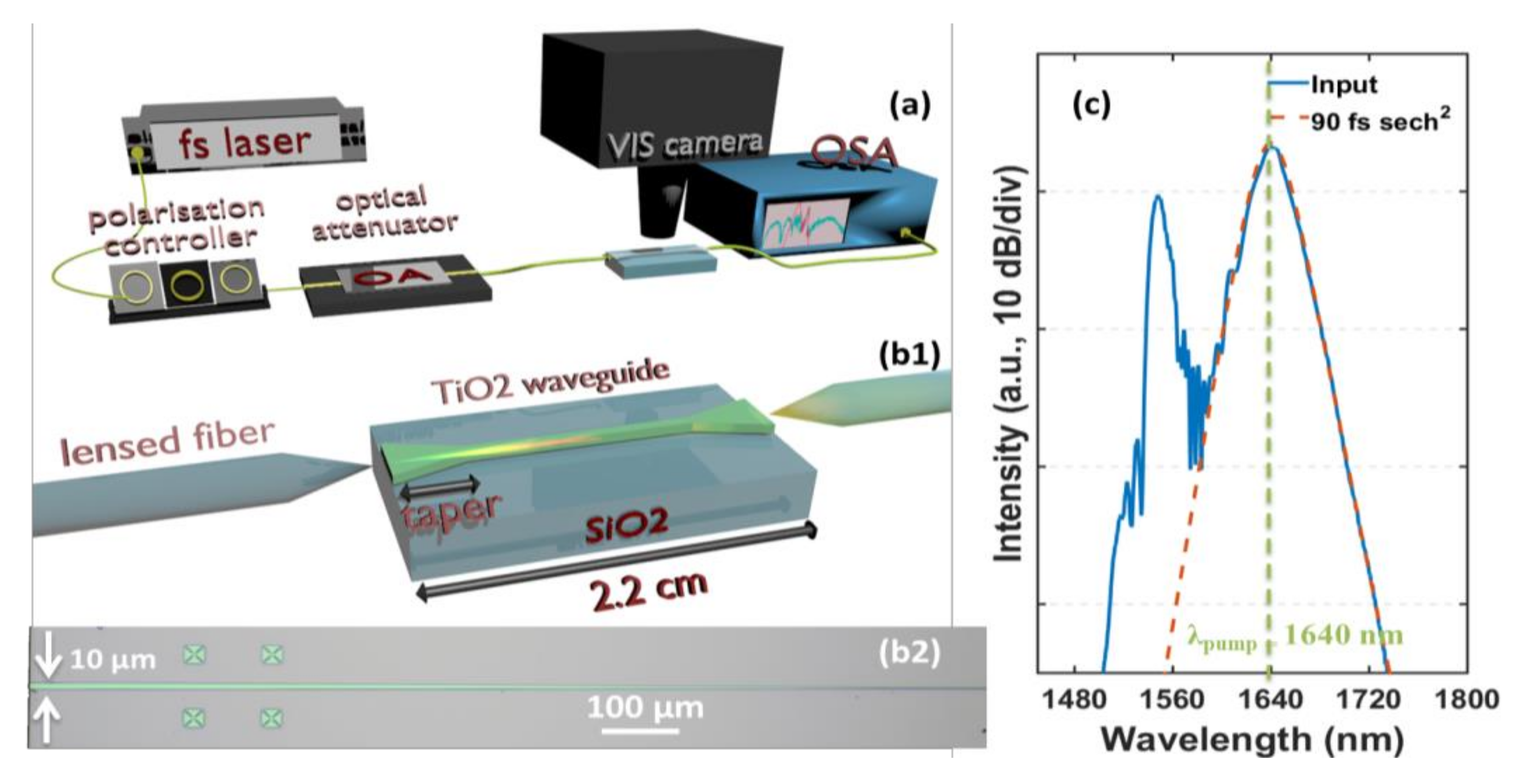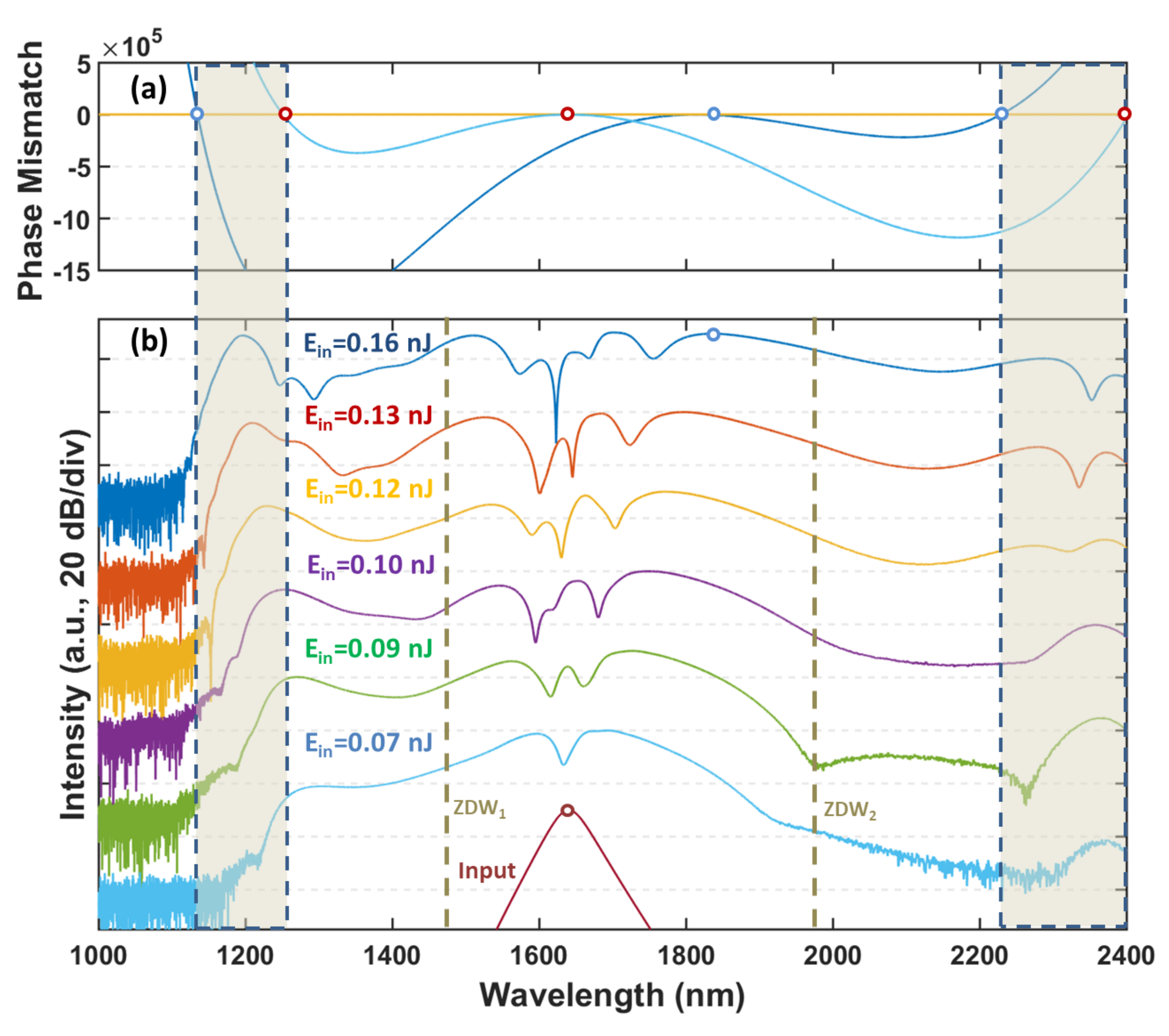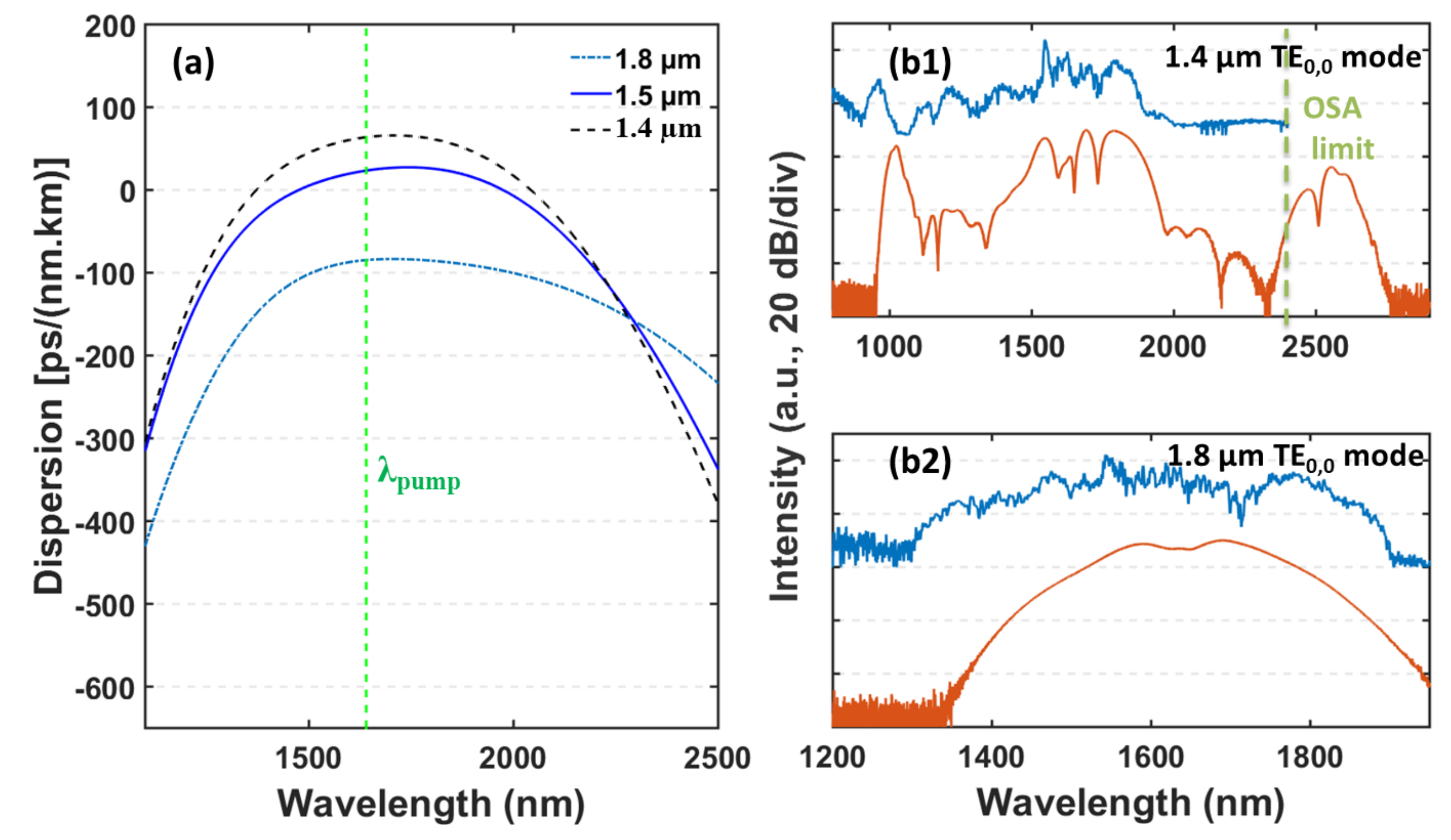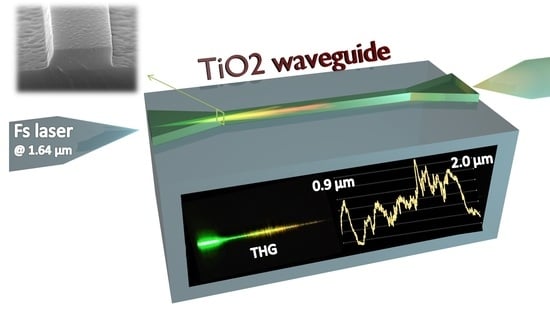Octave Spanning Supercontinuum in Titanium Dioxide Waveguides
Abstract
:1. Introduction
2. TiO2 Waveguide Design and Fabrication
3. Experimental Setup
4. Supercontinuum Generation
4.1. Experimental Results
4.2. Numerical Simulations
4.3. Discussion
5. Conclusions
Acknowledgments
Author Contributions
Conflicts of Interest
References
- Alfano, R.R. The Supercontinuum Laser Source: The Ultimate White Light; Springer: New York, NY, USA, 2016. [Google Scholar]
- Dudley, J.M.; Genty, G.; Coen, S. Supercontinuum generation in photonic crystal fibre. Rev. Mod. Phys. 2006, 78, 1135–1184. [Google Scholar] [CrossRef]
- Dudley, J.M.; Taylor, J.R. Supercontinuum Generation in Optical Fibers; Cambridge University Press: Cambridge, UK, 2010. [Google Scholar]
- Jiang, X.; Joly, N.Y.; Finger, M.A.; Babic, F.; Wong, G.K.L.; Travers, J.C.; Russell, P.S.J. Deep-ultraviolet to mid-infrared supercontinuum generated in solid-core ZBLAN photonic crystal fibre. Nat. Photonics 2015, 9, 133–139. [Google Scholar] [CrossRef]
- Savelli, I.; Mouawad, O.; Fatome, J.; Kibler, B.; Désévédavy, F.; Gadret, G.; Jules, J.-C.; Bony, P.-Y.; Kawashima, H.; Gao, W.; et al. Mid-infrared 2000-nm bandwidth supercontinuum generation in suspended-core microstructured Sulfide and Tellurite optical fibres. Opt. Express 2012, 20, 27083–27093. [Google Scholar] [CrossRef] [PubMed]
- Møller, U.; Yu, Y.; Kubat, I.; Petersen, C.R.; Gai, X.; Brilland, L.; Méchin, D.; Caillaud, C.; Troles, J.; Luther-Davies, B.; et al. Multi-milliwatt mid-infrared supercontinuum generation in a suspended core chalcogenide fibre. Opt. Express 2015, 23, 3282–3291. [Google Scholar] [CrossRef] [PubMed]
- Cheng, T.; Nagasaka, K.; Tuan, T.H.; Xue, X.; Matsumoto, M.; Tezuka, H.; Suzuki, T.; Ohishi, Y. Mid-infrared supercontinuum generation spanning 20 to 151 μm in a chalcogenide step-index fibre. Opt. Lett. 2016, 41, 2117–2120. [Google Scholar] [CrossRef] [PubMed]
- Domachuk, P.; Wolchover, N.A.; Cronin-Golomb, M.; Wang, A.; George, A.K.; Cordeiro, C.M.B.; Knight, J.C.; Omenetto, F.G. Over 4000 nm bandwidth of mid-IR supercontinuum generation in sub-centimeter segments of highly nonlinear tellurite PCFs. Opt. Express 2008, 16, 7161–7168. [Google Scholar] [CrossRef] [PubMed]
- Hsieh, I.-W.; Chen, X.; Liu, X.; Dadap, J.I.; Panoiu, N.C.; Chou, C.-Y.; Xia, F.; Green, W.M.; Vlasov, Y.A.; Osgood, R.M. Supercontinuum generation in silicon photonic wires. Opt. Express 2007, 15, 15242–15249. [Google Scholar] [CrossRef] [PubMed]
- Kuyken, B.; Liu, X.; Osgood, R.M., Jr.; Baets, R.; Roelkens, G.; Green, W.M.J. Mid-infrared to telecom-band supercontinuum generation in highly nonlinear silicon-on-insulator wire waveguides. Opt. Express 2011, 19, 20172–20181. [Google Scholar] [CrossRef] [PubMed]
- Singh, N.; Xin, M.; Vermeulen, D.; Shtyrkova, K.; Li, N.; Callahan, P.T.; Magden, E.S.; Ruocco, A.; Fahrenkopf, N.; Baiocco, C.; et al. Octave-spanning coherent supercontinuum generation in silicon on insulator from 1.06 μm to beyond 2.4 μm. Light Sci. Appl. 2018, 7, 17131. [Google Scholar] [CrossRef]
- Ettabib, M.A.; Xu, L.; Bogris, A.; Kapsalis, A.; Belal, M.; Lorent, E.; Labeye, P.; Nicoletti, S.; Hammani, K.; Syvridis, D.; et al. Broadband telecom to mid-infrared supercontinuum generation in a dispersionengineered silicon germanium waveguide. Opt. Lett. 2015, 40, 4118–4121. [Google Scholar] [CrossRef] [PubMed]
- Lacava, C.; Ettabib, M.; Petropoulos, P. Nonlinear Silicon Photonic Signal Processing Devices for Future Optical Networks. Appl. Sci. 2017, 7, 103. [Google Scholar] [CrossRef]
- Hammani, K.; Ettabib, M.A.; Bogris, A.; Kapsalis, A.; Syvridis, D.; Brun, M.; Labeye, P.; Nicoletti, S.; Petropoulos, P. Towards nonlinear conversion from mid- to near-infrared wavelengths using Silicon Germanium waveguides. Opt. Express 2014, 22, 9667–9674. [Google Scholar] [CrossRef] [PubMed]
- Liu, X.; Pu, M.; Zhou, B.; Krückel, C.J.; Fülöp, A.; Torres-Company, V.; Bache, M. Octave-spanning supercontinuum generation in a silicon-rich nitride waveguide. Opt. Lett. 2016, 41, 1–4. [Google Scholar]
- Halir, R.; Okawachi, Y.; Levy, J.S.; Foster, M.A.; Lipson, M.; Gaeta, A.L. Ultrabroadband supercontinuum generation in a CMOS-compatible platform. Opt. Lett. 2012, 37, 1685–1687. [Google Scholar] [CrossRef] [PubMed]
- Okawachi, Y.; Saha, K.; Levy, J.S.; Wen, Y.H.; Lipson, M.; Gaeta, A.L. Octave-spanning frequency comb generation in a silicon nitride chip. Opt. Lett. 2011, 36, 3398–3400. [Google Scholar] [CrossRef] [PubMed]
- Johnson, A.R.; Mayer, A.S.; Klenner, A.; Luke, K.; Lamb, E.S.; Lamont, M.R.E.; Joshi, C.; Okawachi, Y.; Wise, F.W.; Lipson, M.; et al. Octave-spanning coherent supercontinuum generation in a silicon nitride waveguide. Opt. Lett. 2015, 40, 5117–5120. [Google Scholar] [CrossRef] [PubMed]
- Feigel, B.; Castelló-Lurbe, D.; Thienpont, H.; Vermeulen, N. Opportunities for visible supercontinuum light generation in integrated diamond waveguides. Opt. Lett. 2017, 42, 3804–3807. [Google Scholar] [CrossRef] [PubMed]
- Lamont, M.R.; Luther-Davies, B.; Choi, D.-Y.; Madden, S.; Eggleton, B.J. Supercontinuum generation in dispersion engineered highly nonlinear (γ = 10 /W/m) As2S3 chalcogenide planar waveguide. Opt. Express 2008, 16, 14938–14944. [Google Scholar] [CrossRef] [PubMed]
- Dave, U.D.; Ciret, C.; Gorza, S.-P.; Combrie, S.; de Rossi, A.; Raineri, F.; Roelkens, G.; Kuyken, B. Dispersive-wave-based octave-spanning supercontinuum generation in InGaP membrane waveguides on a silicon substrate. Opt. Lett. 2015, 40, 3584–3587. [Google Scholar] [CrossRef] [PubMed]
- Pu, M.; Ottaviano, L.; Semenova, E.; Yvind, K. Efficient frequency comb generation in AlGaAs-on-insulator. Optica 2016, 3, 823–826. [Google Scholar] [CrossRef]
- Kischkat, J.; Peters, S.; Gruska, B.; Semtsiv, M.; Chashnikova, M.; Klinkmüller, M.; Fedosenko, O.; Machulik, S.; Aleksandrova, A.; Monastyrskyi, G.; et al. Mid-infrared optical properties of thin films of aluminum oxide, titanium dioxide, silicon dioxide, aluminum nitride, and silicon nitride. Appl. Opt. 2012, 51, 6789–6798. [Google Scholar] [CrossRef] [PubMed]
- Evans, C.C.; Shtyrkova, K.; Bradley, J.D.B.; Reshef, O.; Ippen, E.; Mazur, E. Spectral broadening in anatase titanium dioxide waveguides at telecommunication and near-visible wavelengths. Opt. Express 2013, 21, 18582–18591. [Google Scholar] [CrossRef] [PubMed]
- Guan, X.; Hu, H.; Oxenløwe, L.K.; Frandsen, L.H. Compact titanium dioxide waveguides with high nonlinearity at telecommunication wavelengths. Opt. Express 2018, 26, 1055–1063. [Google Scholar] [CrossRef] [PubMed]
- Qiu, F.; Spring, A.M.; Yokoyama, S. Athermal and high-Q hybrid TiO2-Si3N4 ring resonator via an etching-free fabrication technique. ACS Photonics 2015, 2, 405–409. [Google Scholar] [CrossRef]
- Reshef, O.; Shtyrkova, K.; Moebius, M.G.; Griesse-Nascimento, S.; Spector, S.; Evans, C.C.; Ippen, E.; Mazur, E. Polycrystalline anatase titanium dioxide microring resonators with negative thermo-optic coefficient. J. Opt. Soc. Am. B 2015, 32, 2288–2293. [Google Scholar] [CrossRef]
- Guha, B.; Cardenas, J.; Lipson, M. Athermal silicon microring resonators with titanium oxide cladding. Opt. Express 2013, 21, 26557–26563. [Google Scholar] [CrossRef] [PubMed]
- Hadjoub, I.; Touam, T.; Chelouche, A.; Atoui, M.; Solard, J.; Chakaroun, M.; Fischer, A.; Boudrioua, A.; Peng, L.H. Post-deposition annealing effect on RF-sputtered TiO2 thin-film properties for photonic applications. Appl. Phys. A Mater. Sci. Process. 2016, 122, 1–8. [Google Scholar] [CrossRef]
- Quidant, R.; Weeber, J.-C.; Dereux, A.; Peyrade, D.; Chen, Y.; Girard, C. Near-field observation of evanescent light wave coupling in subwavelength optical waveguides. Europhys. Lett. 2002, 57, 191–197. [Google Scholar] [CrossRef]
- Choy, J.T.; Bradley, J.D.B.; Deotare, P.B.; Burgess, I.B.; Evans, C.C.; Mazur, E.; Lon, M. Integrated TiO2 resonators for visible photonics. Opt. Lett. 2012, 37, 539–541. [Google Scholar] [CrossRef] [PubMed]
- Giudicatti, S.; Marz, S.M.; Soler, L.; Madani, A.; Jorgensen, M.R.; Sanchez, S.; Schmidt, O.G. Photoactive rolled-up TiO2 microtubes: fabrication, characterization and applications. J. Mater. Chem. C 2014, 2, 5892–5901. [Google Scholar] [CrossRef] [PubMed]
- Lamy, M.; Finot, C.; Fatome, J.; Arocas, J.; Weeber, J.-C.; Hammani, K. Demonstration of High-Speed Optical Transmission at 2 µm in Titanium Dioxide Waveguides. Appl. Sci. 2017, 7, 631. [Google Scholar] [CrossRef]
- Madani, A.; Harazim, S.M.; Quiñones, V.A.B.; Kleinert, M.; Finn, A.; Naz, E.S.G.; Ma, L.; Schmidt, O.G. Optical microtube cavities monolithically integrated on photonic chips for optofluidic sensing. Opt. Lett. 2017, 42, 486–489. [Google Scholar] [CrossRef] [PubMed]
- Evans, C.C.; Liu, C.; Suntivich, J. TiO2 Nanophotonic Sensors for Efficient Integrated Evanescent Raman Spectroscopy. ACS Photonics 2016, 3, 1662–1669. [Google Scholar] [CrossRef]
- Moebius, M.G.; Herrera, F.; Griesse-Nascimento, S.; Reshef, O.; Evans, C.C.; Guerreschi, G.G.; Aspuru-Guzik, A.; Mazur, E. Efficient photon triplet generation in integrated nanophotonic waveguides. Opt. Express 2016, 24, 9932–9954. [Google Scholar] [CrossRef] [PubMed]
- Abe, K.; Teraoka, E.Y.M.; Kita, T.; Yamada, H. Nonlinear optical waveguides with rutile TiO2. Proc. SPIE 2011, 79401. [Google Scholar] [CrossRef]
- Ma, Y.-J.; Lu, F.; Xiang, B.-X.; Zhao, J.-L.; Ruan, S.-C. Fabrication of TiO2 thin films with both anatase and rutile structures together using the ion-implantation method. Opt. Mater. Express 2018, 8, 532–540. [Google Scholar] [CrossRef]
- Jiang, L.; Evans, C.C.; Reshef, O.; Mazur, E. Optimizing anatase-TiO2 deposition for low-loss planar waveguides. Proc. SPIE 2013, 8626. [Google Scholar] [CrossRef]
- Bradley, J.D.B.; Evans, C.C.; Choy, J.T.; Reshef, O.; Parag, B.; Parsy, F.; Phillips, K.C.; Lon, M.; Mazur, E. Submicrometer-wide amorphous and polycrystalline anatase TiO2 waveguides for microphotonic devices. Opt. Express 2012, 20, 8336–8346. [Google Scholar] [CrossRef] [PubMed]
- Foster, M.A.; Moll, K.D.; Gaeta, A.L. Optimal waveguide dimensions for nonlinear interactions. Opt. Express 2004, 12, 2880–2887. [Google Scholar] [CrossRef] [PubMed]
- Lamy, M.; Hammani, K.; Arocas, J.; Finot, C.; Weeber, J.-C. Broadband etching-free metal grating couplers embedded in titanium dioxide waveguides. Opt. Lett. 2017, 42, 2778–2781. [Google Scholar] [CrossRef] [PubMed]
- Agrawal, G.P. Nonlinear Fiber Optics; Elsevier Science: Amsterdam, The Netherlands, 2013. [Google Scholar]
- Evans, C.C.; Liu, C.; Suntivich, J. Low-loss titanium dioxide waveguides and resonators using a dielectric lift-off fabrication process. Opt. Express 2015, 23, 11160–11169. [Google Scholar] [CrossRef] [PubMed]
- Evans, C.C.; Shtyrkova, K.; Reshef, O.; Moebius, M.; Bradley, J.D.B.; Griesse-Nascimento, S.; Ippen, E.; Mazur, E. Multimode phase-matched third-harmonic generation in sub-micrometer-wide anatase TiO2 waveguides. Opt. Express 2015, 23, 7832–7841. [Google Scholar] [CrossRef] [PubMed]
- Skryabin, D.V.; Gorbach, A.V. Colloquium: Looking at a soliton through the prism of optical supercontinuum. Rev. Mod. Phys. 2010, 82, 1287–1299. [Google Scholar] [CrossRef]
- Mussot, A.; Beaugeois, M.; Bouazaoui, M.; Sylvestre, T. Tailoring CW supercontinuum generation in microstructured fibers with two-zero dispersion wavelengths. Opt. Express 2007, 15, 11553–11563. [Google Scholar] [CrossRef] [PubMed]
- Porcel, M.A.G.; Schepers, F.; Epping, J.P.; Hellwig, T.; Hoekman, M.; Heideman, R.G.; van der Slot, P.J.M.; Lee, C.J.; Schmidt, R.; Bratschitsch, R.; et al. Two-octave spanning supercontinuum generation in stoichiometric silicon nitride waveguides pumped at telecom wavelengths. Opt. Express 2017, 25, 1542–1554. [Google Scholar] [CrossRef] [PubMed]
- Kibler, B.; Fischer, R.; Genty, G.; Neshev, D.N.; Dudley, J.M. Simultaneous fs pulse spectral broadening and third harmonic generation in highly nonlinear fibre: Experiments and simulations. Appl. Phys. B 2008, 91, 349–352. [Google Scholar] [CrossRef]
- Genty, G.; Kinsler, P.; Kibler, B.; Dudley, J.M. Nonlinear envelope equation modeling of sub-cycle dynamics and harmonic generation in nonlinear waveguides. Opt. Express 2007, 15, 5382–5387. [Google Scholar] [CrossRef] [PubMed]
- Finot, C.; Kibler, B.; Provost, L.; Wabnitz, S. Beneficial impact of wave-breaking for coherent continuum formation in normally dispersive nonlinear fibers. J. Opt. Soc. Am. B 2008, 25, 1938–1948. [Google Scholar] [CrossRef]
- Heidt, A.M. Pulse preserving flat-top supercontinuum generation in all-normal dispersion photonic crystal fibers. J. Opt. Soc. Am. B 2010, 27, 550–559. [Google Scholar] [CrossRef]






© 2018 by the authors. Licensee MDPI, Basel, Switzerland. This article is an open access article distributed under the terms and conditions of the Creative Commons Attribution (CC BY) license (http://creativecommons.org/licenses/by/4.0/).
Share and Cite
Hammani, K.; Markey, L.; Lamy, M.; Kibler, B.; Arocas, J.; Fatome, J.; Dereux, A.; Weeber, J.-C.; Finot, C. Octave Spanning Supercontinuum in Titanium Dioxide Waveguides. Appl. Sci. 2018, 8, 543. https://doi.org/10.3390/app8040543
Hammani K, Markey L, Lamy M, Kibler B, Arocas J, Fatome J, Dereux A, Weeber J-C, Finot C. Octave Spanning Supercontinuum in Titanium Dioxide Waveguides. Applied Sciences. 2018; 8(4):543. https://doi.org/10.3390/app8040543
Chicago/Turabian StyleHammani, Kamal, Laurent Markey, Manon Lamy, Bertrand Kibler, Juan Arocas, Julien Fatome, Alain Dereux, Jean-Claude Weeber, and Christophe Finot. 2018. "Octave Spanning Supercontinuum in Titanium Dioxide Waveguides" Applied Sciences 8, no. 4: 543. https://doi.org/10.3390/app8040543





